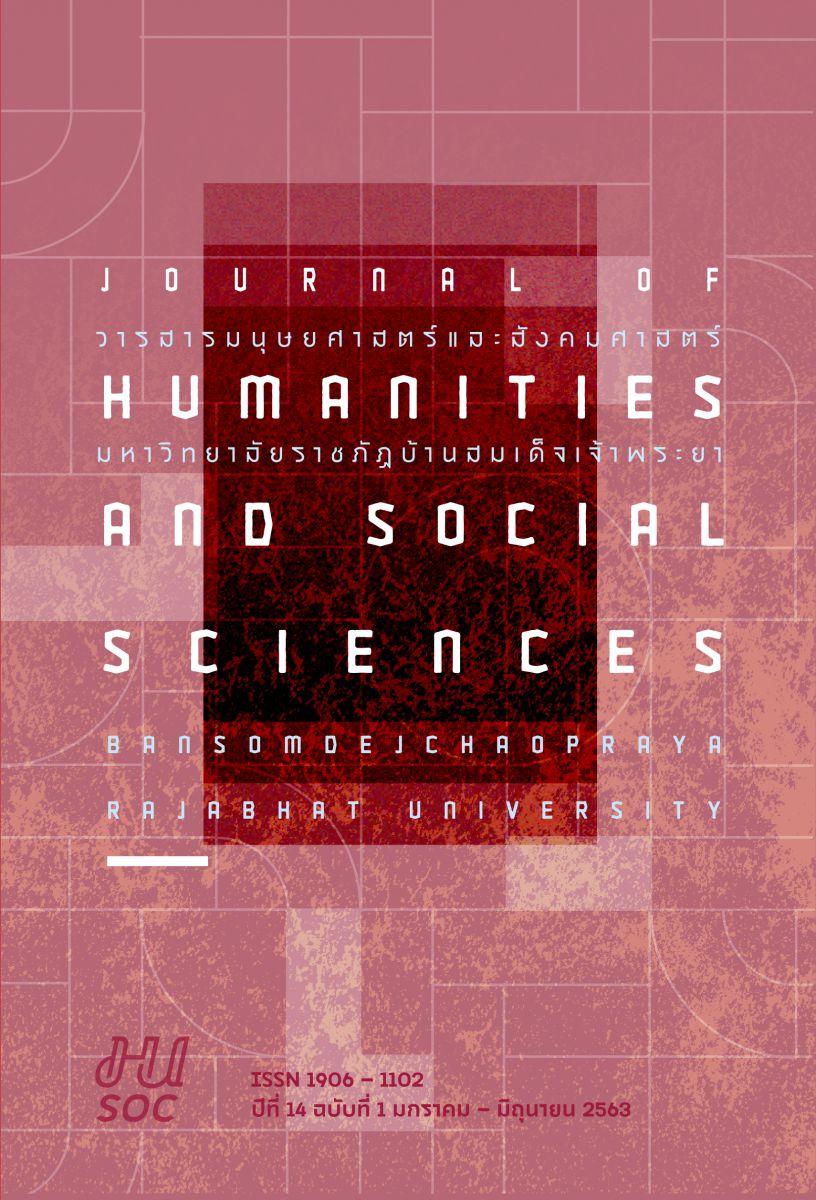Creative Dance of Chuichay Khunpansansathan
Keywords:
The Created Dance, Dance New DesigningAbstract
The created dance of Chuichay Khunpansansathan was studied to assess 1. The history of the khunpan actor in Khun Chang Khunpan literature, and 2. The history and design creativity of the Chuichay khunpansansathan dance. The study revealed that 1) Khun Chang Khunpan is a real-life story from the Ayudhaya period. Khunpan was a royal soldier. He was brave and the best warrior. After getting married he received the royal command to go to war in Chian gthong. Khun Chang used a trick to kidnap Wanthong. When he came back he rode the Simog horse to Khun Chang’s home to kidnap her. This is the fantastic love story through Sepa singing into drama. 2) History of Chuichay dance was originally the singing of villagers only in Ayudhaya period, later in Rattanakosin period. It was performed in royal courts for all famous Lords. The Chuichay song represented happiness and pride and had been performed until the reign of King Rama IV, who later integrated it into a prelude performance of female Lakorn which later on became popular and eventually was depicted in Khon performance to present the emotions of happiness as well as the beauty of actor’s dressing. All of the information above is the creator’s inspiration in designing new Chuichay dance of Chuichaykhunpansansathan by combining the customs of Sepa singing and Punthang drama from Thai dance based on the nature of human being basics by means of adapting the original Chuichay dance to tell about Khunpan’s history, who faced both sadness and happiness. The show was delivered by performers who had to express the feelings through their eyes and facial expressions.In addition, the performance was delivered in pair representing two characters of a man (Khunpan) and a horse (Simog).
References
กรมศิลปากร. (2513). ขุนช้างขุนแผนฉบับหอสมุดแห่งชาติ. กรุงเทพฯ: กรมศิลปากร.
จอมเกล้าเจ้าอยู่หัว, พระบาทสมเด็จพระ. (2555). บทเบิกโรง. กรุงเทพฯ: ต้นฉบับ.
จุลจอมเกล้าเจ้าอยู่หัว, พระบาทสมเด็จพระ. (2512). เงาะป่า. กรุงเทพฯ: ศิลปาบรรณาคาร.
ชัย ว่องกสิกรณ์. (2556). วิเคราะห์บทเบิกโรง พระราชนิพนธ์ในสมเด็จพระบวรราชเจ้ามหาศักดิพลเสพ. [วิทยานิพนธ์ศิลปมหาบัณฑิต. สถาบันบัณฑิตพัฒนศิลป์].
ฤทธิเทพ เถาว์หิรัญ. (2562). กระบวนท่ารำที่สัมพันธ์กัน. [ภาพถ่าย]. กรุงเทพฯ: สถาบันบัณฑิตพัฒนศิลป์.
ฤทธิเทพ เถาว์หิรัญ (2562). ขุนแผนกับม้าสีหมอก. [ภาพถ่าย]. กรุงเทพฯ: สถาบันบัณฑิตพัฒนศิลป์.
ฤทธิเทพ เถาว์หิรัญ. (2562). เครื่องแต่งกายขุนแผน. [ภาพถ่าย]. กรุงเทพฯ: สถาบันบัณฑิตพัฒนศิลป์.
ฤทธิเทพ เถาว์หิรัญ. (2562). เครื่องแต่งกายม้าสีหมอก. [ภาพถ่าย]. กรุงเทพฯ: สถาบันบัณฑิตพัฒนศิลป์.
ฤทธิเทพ เถาว์หิรัญ. (2562). ท่ารำที่สร้างสรรค์ขึ้นจากท่าธรรมชาติ “ท่าเสยผม”. [ภาพถ่าย]. กรุงเทพฯ: สถาบันบัณฑิตพัฒนศิลป์.
ฤทธิเทพ เถาว์หิรัญ. (2562). อุปกรณ์การแสดง “ดาบฟ้าฟื้น”. [ภาพถ่าย]. กรุงเทพฯ: สถาบันบัณฑิตพัฒนศิลป์.
ศุภชัย จันทร์สุวรรณ์. (2556). วิเคราะห์กระบวนท่ารำฉุยฉายฮเนา ตามรูปแบบละครวังสวนกุหลาบ. กรุงเทพฯ: สถาบันบัณฑิตพัฒนศิลป์.
สำนักหอจดหมายเหตุแห่งชาติ. (2562). เครื่องแต่งกายขุนนางผู้ใหญ่สมัยรัชกาลที่ 4. สืบค้น 24 กุมภาพันธ์ 2562. https://www.nat.go.th/คลังความรู้/คลังภาพทรงคุณค่า
สำนักหอจดหมายเหตุแห่งชาติ. (2562). เครื่องแต่งกายผู้ชายไทยสมัยรัชกาลที่ 5. สืบค้น 24 กุมภาพันธ์ 2562. https://www.nat.go.th/คลังความรู้/คลังภาพทรงคุณค่า
สุรพล วิรุฬห์รักษ์. (2547). นาฏยศิลป์ปริทรรศน์. กรุงเทพฯ: จุฬาลงกรณ์มหาวิทยาลัย.
เสาวณิต วิงวอน. (2536). หัวเลี้ยวของนาฏยวรรณกรรมแบบขนบนิยม. กรุงเทพฯ: แสงแดด.
สวภา เวชสุรักษ์. (2547). หลักนาฏยประดิษฐ์ของท่านผู้หญิงแผ้วสนิทวงศ์เสนี. [วิทยานิพนธ์ดุษฎีบัณฑิต. จุฬาลงกรณ์มหาวิทยาลัย].
Downloads
Published
How to Cite
Issue
Section
License
Copyright (c) 2020 Faculty of Humanities and Social Sciences, Bansomdejchaopraya Rajabhat University

This work is licensed under a Creative Commons Attribution-NonCommercial-NoDerivatives 4.0 International License.




